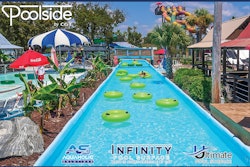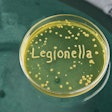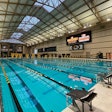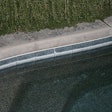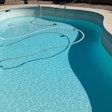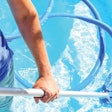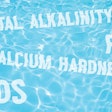
The effects of poor pool water chemistry on the heating systems that serve aquatic facilities can be devastating. Regardless of pool size, improper pool chemistry can lead to unhealthy bathing conditions, inefficient operation, and damaged heating system components.
Unhealthy water conditions are a concern all of their own, so I'd like to address the two main problems related to pool heating equipment: calcium (scale) deposits and corrosion.
Drop a penny into a pool and leave it there for a while. What happens? It starts to stain the surface around it. The copper begins to corrode. Most of the heating components in a pool heating system are manufactured with copper. Heat exchangers are often copper or cupronickel. Balancing pool water correctly reduces the damage done by the pool water.
The first thing we do when we arrive at a customer's pool is test the source water and the pool water. This gives us a profile of the water, showing where challenges may be present.
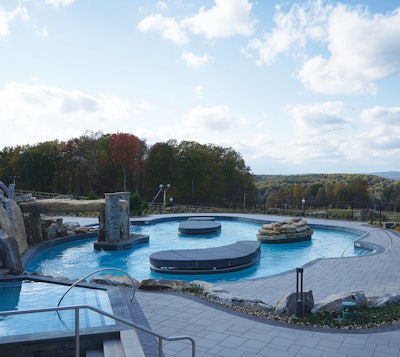 The proper way to add treatment chemicals to a body of water that doesn't feature mechanical injection is to dilute the chemical with water first, then distribute it throughout the pool as evenly as possible.
The proper way to add treatment chemicals to a body of water that doesn't feature mechanical injection is to dilute the chemical with water first, then distribute it throughout the pool as evenly as possible.
What are the total dissolved solids? How much calcium is in the water (hardness), how much sanitizer, is it within balance (LSI, or Langelier Saturation Index)? Unbalanced water will always try to find balance, and the first thing it will attack are the metals it comes in direct contact with. Pool surface finishes are also subject to deterioration. Most of the metals exposed to pool water are in the mechanical system.
The softest metals are the most susceptible to corrosion, and can generally be found in the heat exchangers of the heating appliances, whether these be the direct-fired heat exchangers of the pool heating units themselves, or in a water-to-water heat exchanger installed to isolate pool water from the water within a boiler. We've seen water so aggressive that new pool heaters are completely destroyed within two years.
Hard water, which is a common issue, generally has higher total dissolved solids (TDS). This is a separate issue from corrosive water, but just as large a concern. Water with a high TDS typically contains a high level of calcium, though other minerals can certainly be present. Mineral deposits — also known as scale — are unsightly and can develop on any surface in contact with pool water. But no surface scales over as quickly as a heat exchanger.
When hard water comes in contact with the hot surface of the heat exchanger, the calcium or other minerals fall out of solution and adhere to the metal of the heat exchanger. This creates a number of challenges.
As scale builds up on the heat transfer surfaces, it insulates the water from the heat exchanger, reducing heat transfer and lowering efficiency. Because the heat exchanger is no longer rejecting heat to the water effectively, the unit may short cycle (turn on and off quickly). This only lowers efficiency further and creates excess wear and tear on the heating appliance. Scale buildup also clogs the channels within a heat exchanger, reducing the flow rate. This further lowers efficiency and creates greater pumping resistance, increasing electric consumption and overworking the system pumps.
 Heat exchangers are most susceptible to corrosion, whether they be the direct-fired heat exchangers of the pool heating units themselves, or in a water-to-water heat exchanger installed to isolate pool water from the water within a boiler.
Heat exchangers are most susceptible to corrosion, whether they be the direct-fired heat exchangers of the pool heating units themselves, or in a water-to-water heat exchanger installed to isolate pool water from the water within a boiler.

Proper Chemical Treatment
There are many factors to consider when balancing pool water, even when the chemical water profile is known. For example, water temperature has a major effect on LSI. Chemicals in 80 degrees Fahrenheit pool water will react differently than in 102 degrees Fahrenheit spa water. As temperature increases, so does the rate of corrosion. Doing the math longhand is extremely difficult, with so many variables and so many different chemicals.
To simplify the process, we use the Orenda Calculator app, by Orenda Technologies. Once you've received your water quality test results, you input the values, and the app provides a solution for which chemicals to use and how much, based on the volume of the pool and temperature of the water.
Even with that knowledge, however, mistakes can still occur while introducing chemicals to the pool. We've regularly found that people maintaining small pools (residential or commercial) tend to dump treatment chemicals directly into the pool skimmer. This mainlines the chemical through the pumps and heat exchangers, meaning that un-diluted chemical comes in direct contact with the components most susceptible to corrosion. Imagine a highly acidic compound flowing through the heat exchanger. These chemicals can be super corrosive when not properly diluted.
The proper way to add treatment chemicals to a body of water that doesn't feature mechanical injection is to dilute the chemical with water first, then distribute it throughout the pool as evenly as possible. If it's not diluted first, the chemicals — which are generally heavier than water — can sink to the bottom of the pool and get sucked into the main drains, which achieves the same bad result as dumping chemicals into the skimmer.
Incorrectly adding chemicals is possible even in large commercial applications where properly calibrated mechanical chemical injection is installed. Most injection systems are installed between the effluent side of the heat exchanger and the pool. This is fine, but we've often found that the installer failed to provide a check valve between the heat exchanger and the point of injection. If the pumps are turned off and suction is somehow created, the concentrated treatment chemicals can be drawn back into the heat exchanger, causing damage.
There's no shortcut to water balancing and chemical treatment. It takes time and knowledge. It's also extremely important to follow the manual when installing any pool equipment, whether that be a heater, chemical injection equipment or pumps. The manufacturers of pool heaters always list water quality parameters that must be followed to ensure their warranties. They do so because water quality and proper installation is critical.
 Pool surface finishes are at greater risk of premature deterioration when exposed to unbalanced pool water, potentially causing the need for costly resurfacing.
Pool surface finishes are at greater risk of premature deterioration when exposed to unbalanced pool water, potentially causing the need for costly resurfacing.
Tom Soukup is the principal of Patriot Water Works Co. with over 20 years as a hydronic designer and installer. He specializes in high efficiency and green technology and brings his expertise to custom commercial work, pool heating, and agricultural projects. Reach him at [email protected].
This article first appeared in the September 2023 issue of AQUA Magazine — the top resource for retailers, builders and service pros in the pool and spa industry. Subscriptions to the print magazine are free to all industry professionals. Click here to subscribe.





























